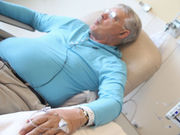Highest survival benefit for addition of AC to CRT, with consistent improvement for all end points
MONDAY, Dec. 19, 2016 (HealthDay News) — For nonmetastatic nasopharyngeal carcinoma, the addition of adjuvant chemotherapy (AC) to chemoradiotherapy (CRT) is associated with the highest survival benefit, according to research published online Dec. 5 in the Journal of Clinical Oncology.
Laureen Ribassin-Majed, Ph.D., from the Université Paris-Saclay, and colleagues compared available treatments using individual patient data from the Meta-Analysis of Chemotherapy in Nasopharynx Carcinoma database. They considered all randomized trials of radiotherapy (RT) with or without chemotherapy in nonmetastatic nasopharyngeal carcinoma; data were included from 20 trials and 5,144 patients.
The researchers found that the three treatments with the highest probability of benefit on overall survival were CRT followed by AC (CRT-AC), CRT, and induction chemotherapy followed by CRT (IC-CRT), with hazard ratios of 0.65 (95 percent confidence interval [CI], 0.56 to 0.75), 0.77 (95 percent CI, 0.64 to 0.92), and 0.81 (95 percent CI, 0.63 to 1.04), compared with RT alone. For CRT-AC versus CRT alone, the hazard ratios were 0.85 (95 percent CI, 0.68 to 1.05) for overall survival, 0.81 (95 percent CI, 0.66 to 0.98) for progression-free survival, 0.70 (95 percent CI, 0.48 to 1.02) for locoregional control, and 0.87 (95 percent CI, 0.61 to 1.25) for distant control (DC).
“The addition of AC to CRT achieved the highest survival benefit and consistent improvement for all end points,” the authors write. “The addition of IC to CRT achieved the highest effect on DC.”
Several authors disclosed financial ties to the pharmaceutical industry.
Full Text
Copyright © 2016 HealthDay. All rights reserved.








